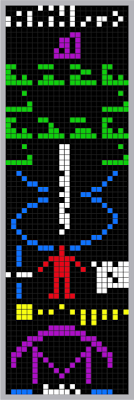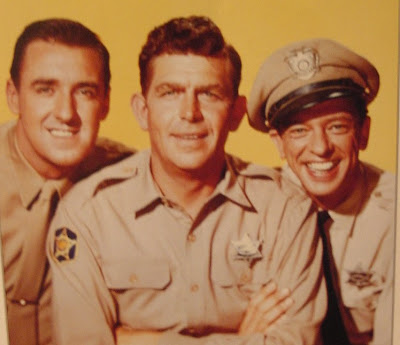For the last forty years or so, we've beamed messages into the cosmos in hopes of contacting our cousins—if we actually have cousins—way Out There. We take our best guess and fire off something we hope they're smart enough to decode or understand. Some of this stuff is pretty strange, to say the least.
 photo courtesy of Nasa/Jet Propulsion LabThe Pioneer Plaques are identical, gold-plated plaques
photo courtesy of Nasa/Jet Propulsion LabThe Pioneer Plaques are identical, gold-plated plaques attached to the Pioneer 10 and 11 spacecraft. With a picture of the solar system (which they would presumably understand), a picture of the Pioneer, and a picture of "a hyperfine transition of neutral hydrogen," we were sure that whoever was smart enough to recover our spacecraft would Get It.
 The Pioneer Plaque attached to Voyager 10, photo courtesy of Nasa/Jet Propulsion Lab
The Pioneer Plaque attached to Voyager 10, photo courtesy of Nasa/Jet Propulsion Lab
According to NASA, The Pioneer Plaque "
is designed to show scientifically educated inhabitants of some other star system, who might intercept it millions of years from now, when Pioneer was launched, from where, and by what kind of beings. (With the hope that they would not invade Earth.) The design is etched into a 6 inch by 9 inch gold-anodized aluminum plate, attached to the spacecraft's attenna support struts in a position to help shield it from erosion by interstellar dust. The radiating lines at left represents the positions of 14 pulsars, a cosmic source of radio energy, arranged to indicate our sun as the home star of our civilization. The "1-" symbols at the ends of the lines are binary numbers that represent the frequencies of these pulsars at the time of launch of Pioneer F relative of that to the hydrogen atom shown at the upper left with a "1" unity symbol. The hydrogen atom is thus used as a "universal clock," and the regular decrease in the frequencies of the pulsars will enable another civilization to determine the time that has elapsed since Pioneer F was launched. The hydrogen is also used as a "universal yardstick" for sizing the human figures and outline of the spacecraft shown on the right. The hydrogen wavelength, about 8 inches, multiplied by the binary number representing "8" shown next to the woman gives her height, 64 inches. The figures represent the type of creature that created Pioneer. The man's hand is raised in a gesture of good will. Across the bottom are the planets, ranging outward from the Sun, with the spacecraft trajectory arching away from Earth, passing Mars, and swinging by Jupiter."The Voyager Record, is literally a metal record...an LP...a long-player. It even includes Chuck Berry's "Johnny B. Goode."
 Photograph of the Voyager Record photo courtesy of Nasa/Jet Propulsion LabThe 12 inch gold-plated copper discs
Photograph of the Voyager Record photo courtesy of Nasa/Jet Propulsion LabThe 12 inch gold-plated copper discs contain "
greetings in 60 languages, samples of music from different cultures and eras, and natural and man-made sounds from Earth. They also contain electronic information that an advanced technological civilization could convert into diagrams and photographs. Currently, both Voyager probes are sailing adrift in the black sea of interplanetary space, having left our solar system years ago." The Arecibo Image
The Arecibo Image is a short binary message beamed into space. When decoded, it creates an image that looks similar to an 80's video game.
Dr. Frank Drake, of Cornell University, wrote the message, with help from Carl Sagan, and others. The encoded message has seven parts:
1) the numbers one (1) through ten (10):
2) the atomic numbers of the elements hydrogen, carbon, nitrogen, oxygen, and phosphorus which make up DNA
3) the formulas for the sugars and bases in the nucleotides of DNA/the number of nucleotides in DNA
4) a graphic of the double helix structure of DNA
5) a graphic figure of a man, the dimension (physical height) of an average man, and the human population of Earth
6) a graphic of Earth's solar system
7) a graphic of the Arecibo radio telescope and the dimension (the physical diameter) of the transmitting antenna dish. [Ed's note: Arecibo in Puerto Rico sends messages to the universe, and is the site where SETI attempts to track blips in the universe and link them to other intelligent beings.]
It will take 25,000 years for the message to reach its target of of stars (and, presumably, an additional 25,000 years for the return trip for any reply). Interestingly, the stars the message is aimed at will no longer be there when it arrives. According to a Cornell News press release of Nov. 12, 1999, the real purpose of the message was not to make contact, but to demonstrate the capabilities of newly installed equipment.
The Teenage Message was beamed into space in 2001. It starts with some radio-transmission Doppler-tuning and then segues into theremin music, and ends with more binary images, including a logo for the Teenage Message program itself.
 According to SETI, in 2001, "a group of Russian teens from Moscow, Kaluga, Voronezh, and Zheleznogorsk participated directly and via the Internet in composing a Teen-Age Message (TAM) to extraterrestrial intelligence, and in the selection of target stars. Their messa was transmitted in the Autumn of that year, from the Evpatoria Deep Space Center
According to SETI, in 2001, "a group of Russian teens from Moscow, Kaluga, Voronezh, and Zheleznogorsk participated directly and via the Internet in composing a Teen-Age Message (TAM) to extraterrestrial intelligence, and in the selection of target stars. Their messa was transmitted in the Autumn of that year, from the Evpatoria Deep Space Center."
"Two previous interstellar radio messages (IRM), one transmitted from Arecibo in 1974 and the one from Evpatoria in 1999, had digital format and represented binary scans of one (Are) or 23 (Evp) black-and-white stylized images. But one might suppose that transmission of analog IRMs is also possible. So, before composing the message's content (as well as trying to decode future signals from ETI), let us try to determine such a message's possible format and structure."Television Signals are a longstanding science fiction trope in which greys, or "Martians," or aliens intercept television shows and are so impressed with a show that it becomes the basis for their entire civilization. You may have seen some variation of this story on
The Twilight Zone. If our TV signals really do become extraterrestrial messages, who wouldn't love to see the results?
 I'd like to see the Hee Haw or the Andy Griffith Show
I'd like to see the Hee Haw or the Andy Griffith Show as the basis of a civilization, or maybe
Celebrity Boxing, F Troop, The Beverly Hillbillies, My Mother The Car, or maybe even
Cop Rock.
---o0o---












